桃解除自然休眠所需的有效低温时数或单位数为桃的需冷量,桃的叶芽和花芽均需要满足需冷量才能解除自然休眠、获得理想的营养生长和最佳的果实承载能力,否则即使条件适宜,桃也不能适期萌发,或萌发不整齐,影响生长开花和授粉坐果,最终影响树体健康和果实的产量及品质[1]。目前桃树需冷量的常用估算模型有0~7.2 ℃模型[2]、7.2 ℃模型[3]和犹它模型[4],在不同地区适宜采用的需冷量模型有所不同[1,5-11]。
桃自然休眠解除后花芽需要一定有效热量的积累才能萌芽开花,即桃的需热量。与需冷量一样,桃的需热量也具有遗传性,不同品种间存在差异[6-8,10-14]。桃需热量的常用估算模型有生长度时数模型[15]和有效积温模型[16]。有研究表明,桃需热量比需冷量对开花期的调控更为重要[7,17]。
截止到目前,对桃需冷量的累计评价资源份数已有660 余份[1,6-7,14,18-20],而需热量累计评价仅70余份[7,10-12,21],同时对较大样本桃花芽和叶芽的需冷量和需热量进行系统比较和相关性分析还未见报道。
笔者采用3 种不同需冷量模型和2 种不同需热量模型,连续2 a(年)对103份桃种质花芽和叶芽的需冷量和需热量进行估算;对不同年际间、不同模型间、不同种质间、花芽与叶芽间、需冷量与需热量间,以及需冷量和需热量与盛花期和展叶期之间的关系进行了全面系统的分析,以期了解103 份桃种质在南京地区生态条件下花芽和叶芽的需冷量和需热量要求,筛选出相对准确、稳定和实用的评价模型,并对桃需冷量和需热量的关系及其影响开花展叶的作用规律进行探究,以便为品种选育和栽培推广实践工作提供一定的参考。
1 材料和方法
1.1 试验时间、地点
田间试验于2018—2020 年在江苏省农业科学院国家果树种质南京桃资源圃进行,室内实验在江苏省高效园艺作物遗传改良重点实验室进行。
1.2 试验材料
供试的103份桃种质取自江苏省农业科学院国家果树种质南京桃资源圃(北纬31°14’,东经118°22’),种质具体情况见表1。土壤表层肥沃,排灌通畅,树龄为3~4 a生,统一管理,生长正常。
表1 103 份桃种质具体情况
Table 1 Specific situation of 103 peach germplasm
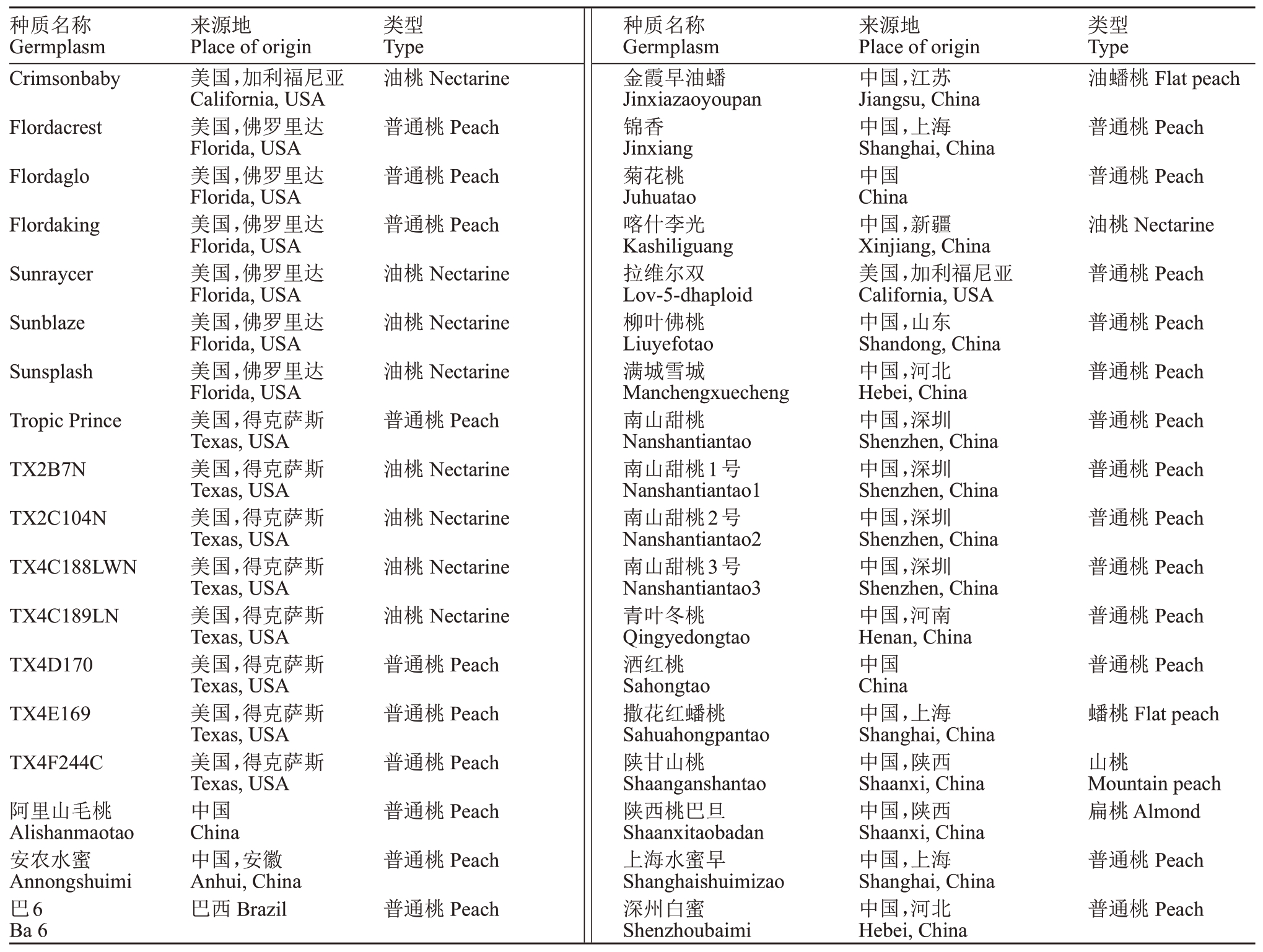
?
表1 (续) Table 1(continued)
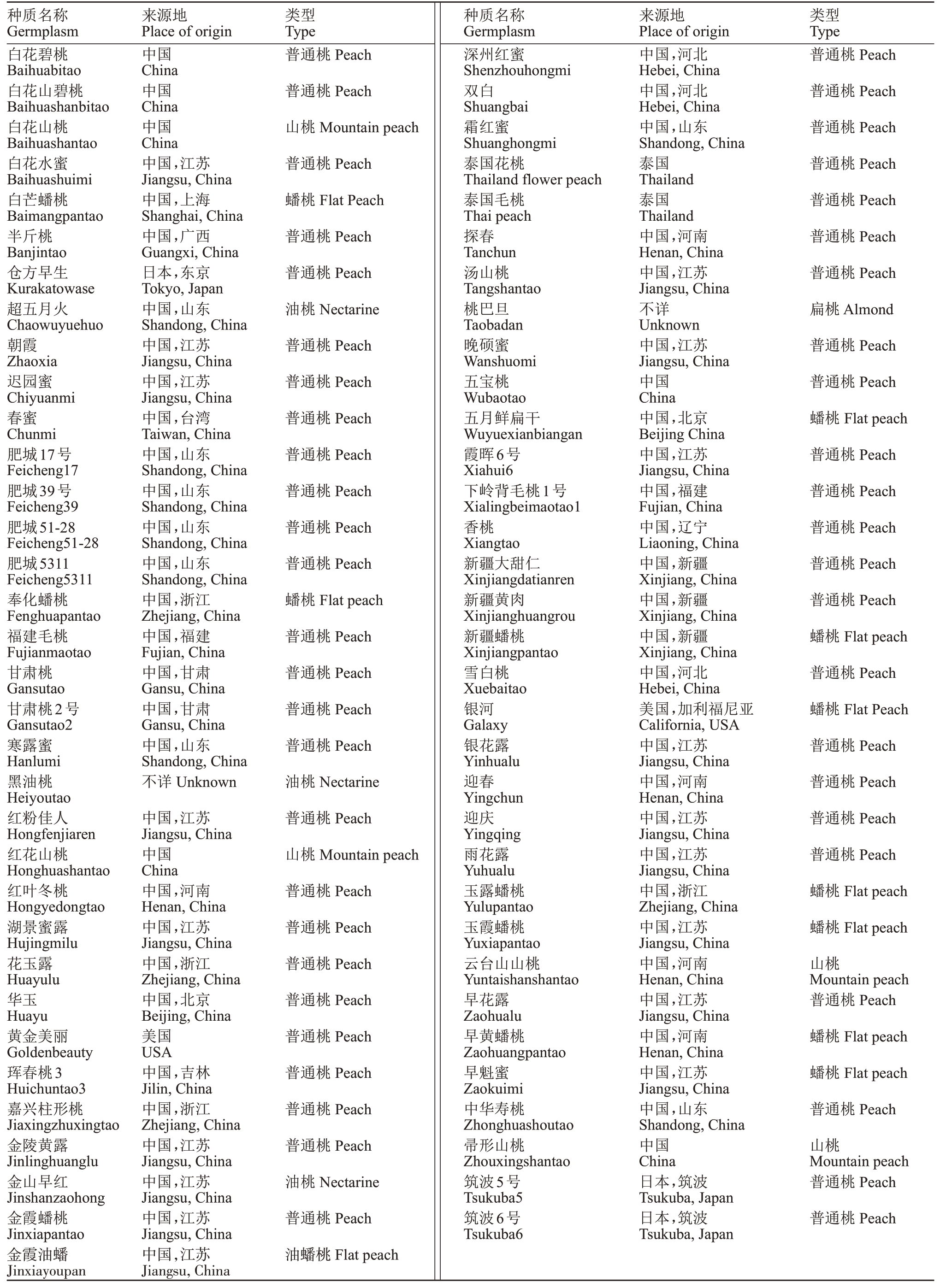
?
1.3 试验方法
1.3.1 温度数据记录 从每年11 月1 日到翌年4 月16 日,由自计温度仪记录每小时的温度,该时间段内,2019—2020 年平均温度(12.06 ℃)比2018—2019年(8.79 ℃)偏高,平均高3.27 ℃(图1)。

图1 桃种质圃气温对比
Fig.1 Temperature comparison of peach germplasm nursery
1.3.2 桃枝条培养 参照王力荣等[5,22]的方法并稍加修改。从落叶期开始,每隔5 d 或冷量积累大于50 h,从田间生长健壮的树体上随机选取1 a生枝条5 枝,长度30~40 cm,枝条基部留5 cm 左右无芽部分。枝条采回后,剪平枝条基部,插入约3 cm 深的5%(ρ)蔗糖溶液中,立即移入到玻璃加温温室。温室控制培养条件:温度(昼/夜)25 ℃/25 ℃,光/暗时数12 h/12 h,光照强度2 000 lx,空气相对湿度为60%~70%。每隔3 d换1次蔗糖溶液,并将枝条基部剪去2~3 mm,露出新茬。培养12 d后进行分级统计和计算。叶芽分级标准(图2-A~E):1 级,未萌动;2级,萌动;3 级,顶尖露绿;4 级,叶伸出;5 级,叶开放。花芽分级标准(图2-F~J):1级,未萌动;2级,顶端露绿;3 级,顶端露红;4 级,花蕾期;5 级,花朵开放。当各级的芽数加权平均值等于或大于2.5时,则采样日为休眠结束日期。计算公式![]()
![]() 式中:GR为萌发率,%;i为叶芽或花芽萌发级别;Χi为萌芽数。
式中:GR为萌发率,%;i为叶芽或花芽萌发级别;Χi为萌芽数。
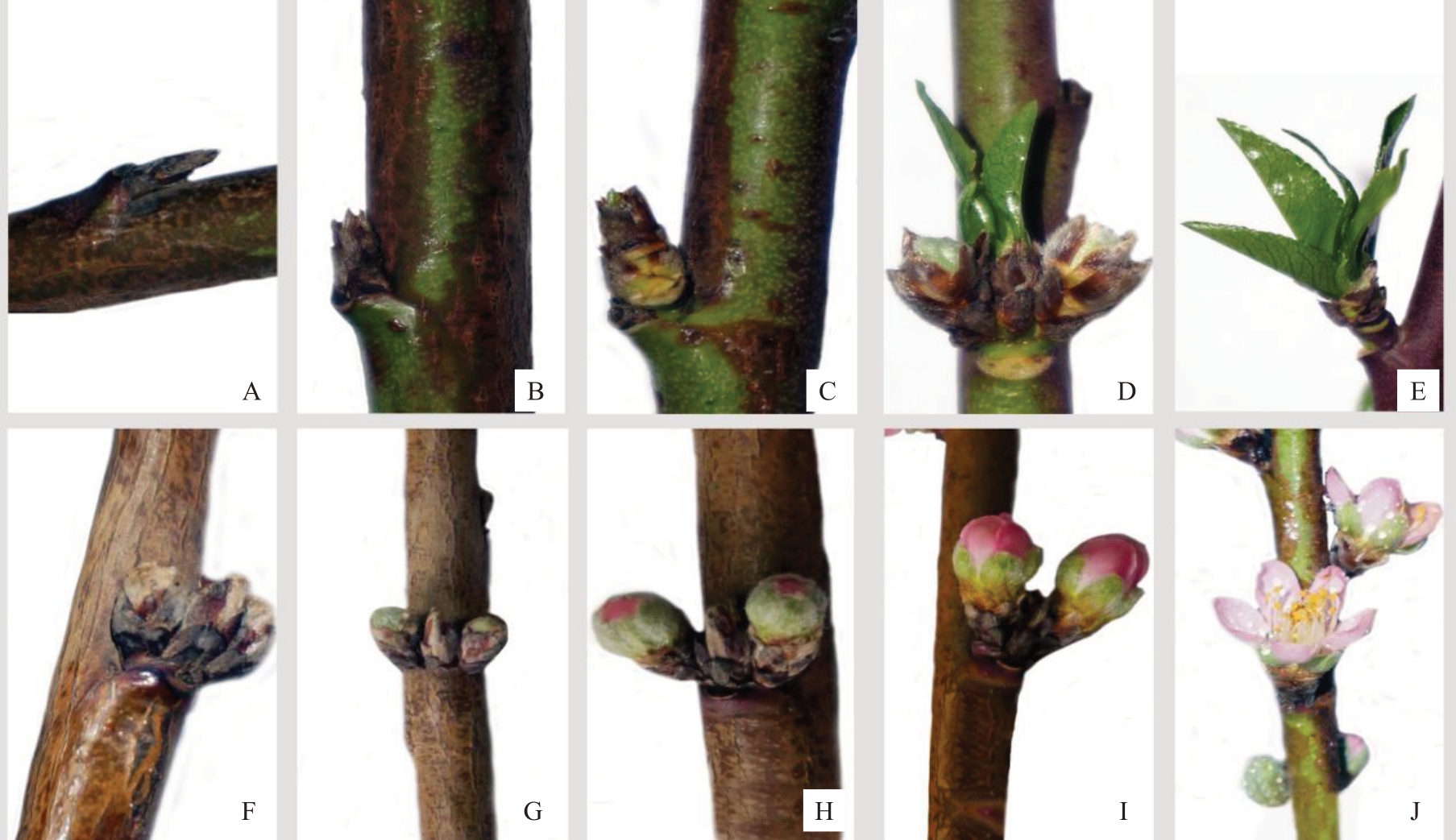
图2 桃叶芽和花芽分级示意图
Fig.2 Grade of leaf and floral buds
A~E.叶芽分级图,品种为南山甜桃;F~J,花芽分级图,品种为Sunsblaze。
A-E.Reference variety for leaf buds is Nanshantiantao;F-J,Reference variety for floral buds is Sunsblaze.
连续2 a 对103 份桃种质的盛花期和展叶期进行田间调查。方法参见《桃种质资源描述规范和数据标准》[22],桃植株全树25%花完全开放的时间为盛花期;桃植株5%叶芽的第1枚叶片铺平展开的时间为展叶期。
1.3.3 需冷量和需热量的计算方法 试验采用0~7.2 ℃模型[2]、7.2 ℃模型[3]和犹它模型[4]对桃需冷量进行估算。0~7.2 ℃模型和7.2 ℃模型确定的低温累积起点,2018—2019 年为12 月6 日,2019—2020年为11月27日。2018—2019年(11月1日—4月16日平均气温8.79 ℃)根据犹它模型确定的低温累积起点为12 月29 日,2019—2020 年(11 月1 日—4 月16日平均气温12.06 ℃)气温偏高,犹它模型不能确定低温累积起点。
采用生长度时数模型[15]和有效积温模型[16]对桃开花展叶所需要的热量进行估算。生长度时数模型:单位为GDH·℃,当温度≤4.5 ℃时,累积1 h需热量为0 GDH·℃;当温度为4.5~25.0 ℃时,累积1 h需热量为GDH·℃=t-4.5;当温度≥25 ℃时,累积1 h需热量为20.5 GDH·℃。有效积温模型:需热量(有效积温)=∑(日平均气温-生物学零度),单位为D·℃,桃的生物学零度为4 ℃[23],计算简单方便。
1.3.4 数据统计 试验数据采用SPSS 22.0 软件进行t 检验和相关性分析,采用Excel(Office 2003)软件进行数据分析和作图。
2 结果与分析
2.1 103 份桃花芽和叶芽的自然休眠结束期、盛花期和展叶期
103份桃种质花芽和叶芽的自然休眠结束期在各时段的种质份数分布图见图3-A,可一定程度上说明2 a 的自然休眠期差异不明显;但是,对于盛花期和展叶期,绝大多数种质2019—2020年比2018—2019 年提前1~2 周(图3-B),这可能与2019—2020年气温偏高、热量积累迅速有关。
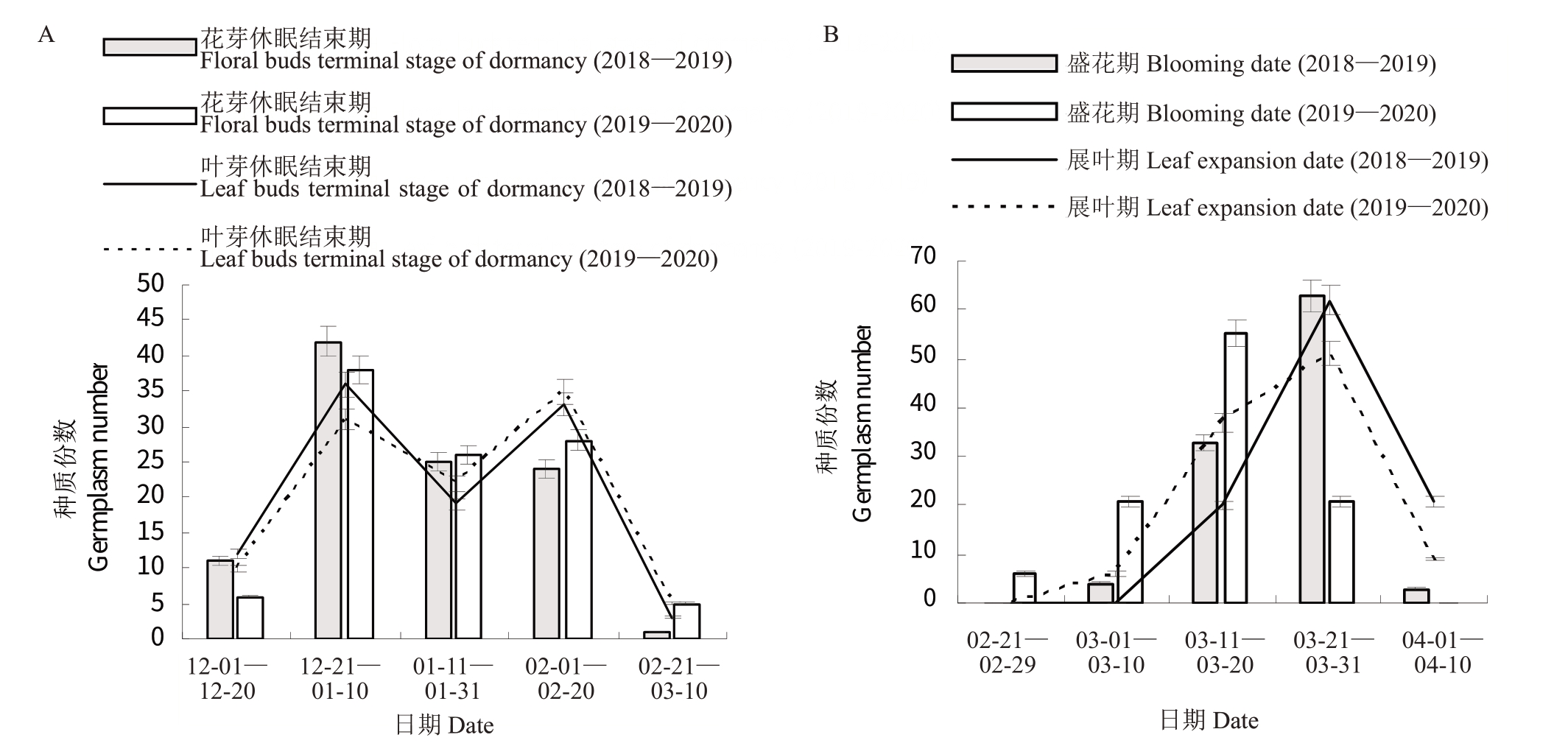
图3 桃芽自然休眠结束期、盛花期和展叶期统计
Fig.3 Terminal stage of natural dormancy,blooming date and leaf expansion date of peach buds
A. 桃芽自然休眠结束期统计;B. 桃芽盛花期和展叶期统计。
A.Terminal stage of natural dormancy of peach buds;B.Blooming date and leaf expansion date of peach buds.
2.2 103份桃种质不同模型下的需冷量
根据103份桃自然休眠结束期和田间实际测得的气温值,采用3 种需冷量模型对2018—2019 年和2019—2020年两年花芽、叶芽需冷量进行估算统计。
犹它模型不适宜该地区桃需冷量的估算,2018—2019 年计算的花芽需冷量为140~644 C·U,叶芽需冷量为211~675 C·U,对低需冷量资源无法进行估算;2019—2020 年由于气温过高,不能达到估算的低温累积起点。0~7.2 ℃模型连续2 a 估算103 份种质花芽和叶芽需冷量的相对标准偏差(RSD)平均值分别为6.74%和7.93%,而7.2 ℃模型的相对标准偏差(RSD)平均值均较大,为9.88%和9.57%。通过t 检验,0~7.2 ℃模型估算的叶芽需冷量RSD 与7.2 ℃模型估算结果差异不显著,但是0~7.2 ℃模型估算的花芽需冷量RSD 极显著小于7.2 ℃模型的估算结果(p <0.01)。综合而言,0~7.2 ℃模型计算的花芽和叶芽需冷量年份间差异更小,稳定性好,初定为南京地区桃需冷量评价的最优模型。
利用0~7.2 ℃模型估算的花芽和叶芽2 a 的需冷量平均值(花芽为151~1 264 h、叶芽为187~1 108 h),筛选到花芽和叶芽需冷量均低(150 h左右)的有‘迎春’和‘下岭背毛桃1号’等;花芽和叶芽需冷量均高(1 200 h左右)的有‘肥城51-28’‘香桃’和‘菊花桃’等。以花芽需冷量为横坐标,叶芽需冷量为纵坐标,作散点图(图4),拟合出线性方程,以比较桃种质花芽和叶芽需冷量的关系,花芽和叶芽散点趋势线方程为y=0.96 x+31.59,斜率为0.96,表明大部分桃花芽和叶芽的需冷量基本一致。但‘帚形山桃’和‘红花山桃’表现特异,其叶芽需冷量约为花芽需冷量的5倍。
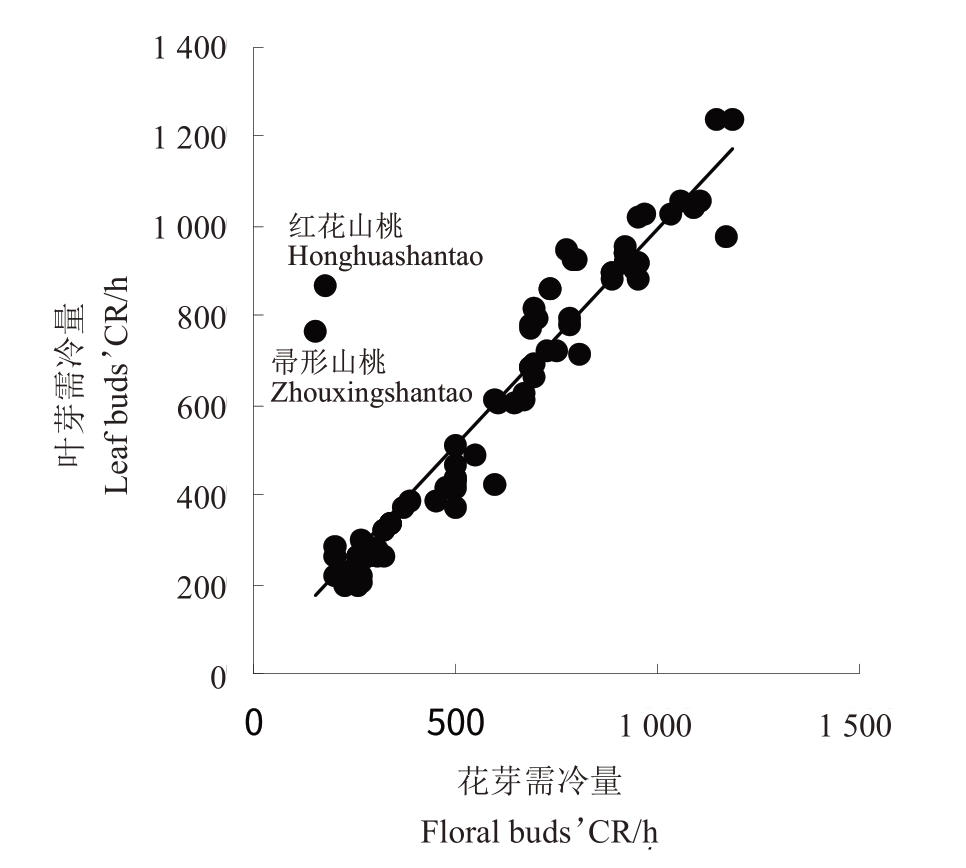
图4 0~7.2 ℃模型估算的桃芽需冷量比较
Fig.4 Comparison of CR in peach buds by 0-7.2 ℃model
2.3 103份桃种质不同模型下的需热量
根据103份桃自然休眠结束期和田间实际测得的气温,采用2 种需热量模型进行估算统计2018—2019年和2019—2020年2 a花芽、叶芽需热量。
应用有效积温模型连续2 a 估算的103 份桃种质花芽和叶芽需热量的RSD平均值分别为9.05%和5.68%,相比之下,生长度时数模型的RSD平均值均较大,为10.55%和14.61%;通过t 检验,有效积温模型估算的花芽需热量RSD 与生长度时数模型估算结果差异不显著,但是有效积温模型估算的叶芽需热量RSD 极显著小于生长度时数模型估算结果(p <0.01)。综合而言,有效积温模型计算的花芽和叶芽需热量年份间差异更小,稳定性好,初定为南京地区桃种质需热量评价的最优模型。
利用有效积温模型估算的花芽和叶芽2 a 的需热量平均值(花芽为256~391 D·℃、叶芽为267~498 D·℃),筛选到花芽和叶芽需热量均低的桃种质有‘新疆黄肉’‘迎庆’和‘红花山桃’等;花芽和叶芽需热量均高的桃种质有‘新疆大甜仁’‘青叶冬桃’‘华玉’等。图5-A 是以花芽需热量为横坐标,叶芽需热量为纵坐标的散点图,可见散点集中分布在直线(斜率为1)上方,表明桃叶芽需热量均较明显高于花芽;图5-B为叶芽与花芽需热量比值频次图,两者间比值范围为1.0~1.6,大部分桃种质叶芽需热量是花芽的1.2~1.4倍,其中‘菊花桃’和‘喀什李光’叶芽需热量是花芽的1.5倍以上。
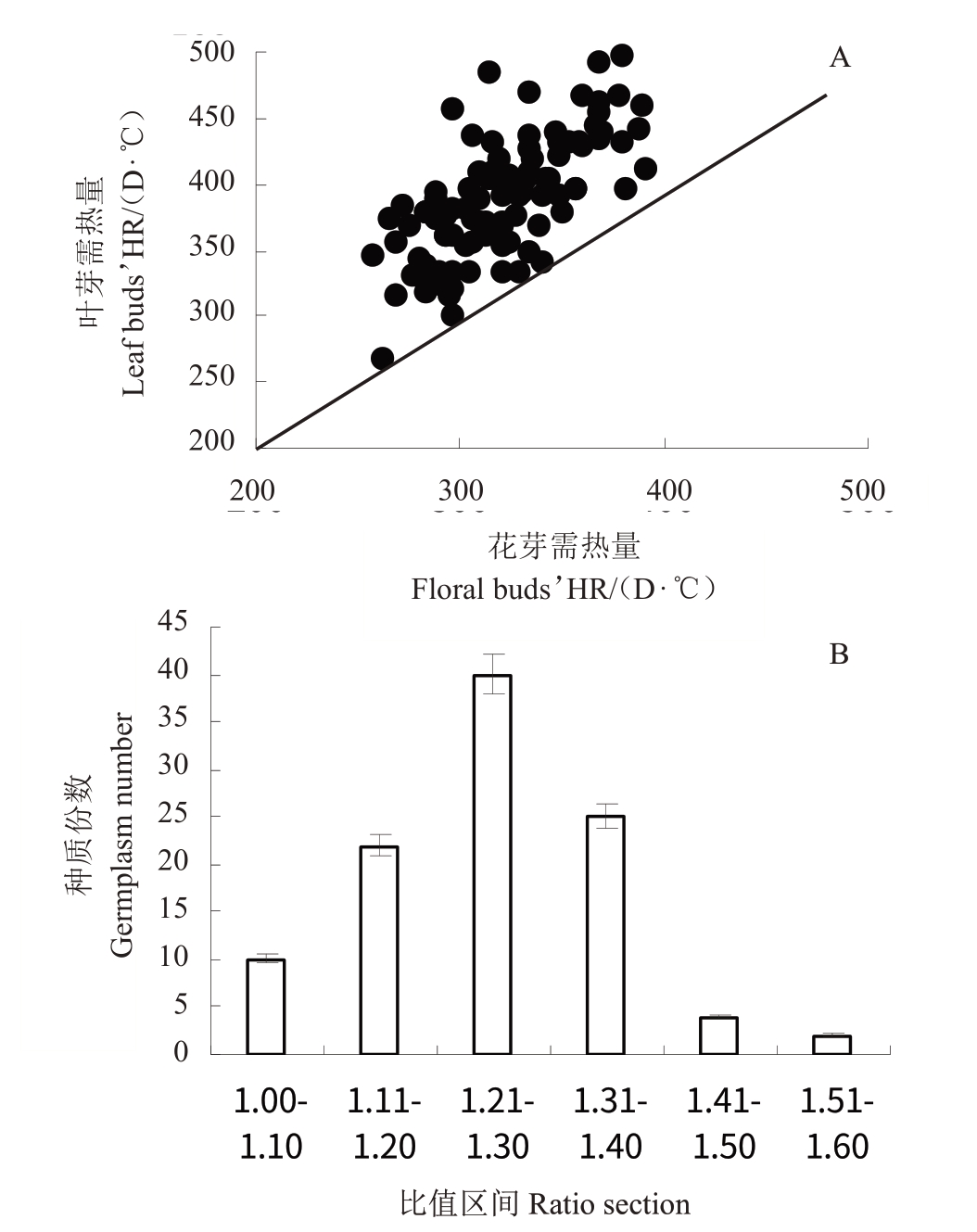
图5 花芽与叶芽需热量的关系比较
Fig.5 Comparison of HR in floral buds and leaf buds
A. 有效积温模型估算的桃芽需热量比较;B. 叶芽与花芽需热量比值频次图。
A.Comparison of HR in peach buds by effective temperature model;B.Frequency distribution for ratio of leaf buds’HR to floral buds’HR.
2.4 桃需冷量与需热量的关系
利用0~7.2 ℃模型和有效积温模型估算了花芽和叶芽2 a的需冷量和需热量平均值,比较了103份桃种质需冷量与需热量的关系(表2)。0~7.2 ℃模型估算的花芽和叶芽需冷量与有效积温模型估算的花芽和叶芽需热量无显著相关关系。
表2 花芽和叶芽需冷量与需热量之间的关系
Table 2 Correlation of CR and HR in floral and leaf buds

?
2.5 桃需冷量和需热量与开花展叶的关系
采用0~7.2 ℃需冷量估算模型,连续2 a需冷量与盛花期均呈现出明显的规律,即需冷量低的种质,开花较早;需冷量高的种质,开花较晚(图6-A~B);连续2 a 有效积温模型估算的花芽需热量与开花早晚表现出明显的规律,即需热量低的种质,开花较早;需热量高的种质,开花较晚(图6-C~D)。
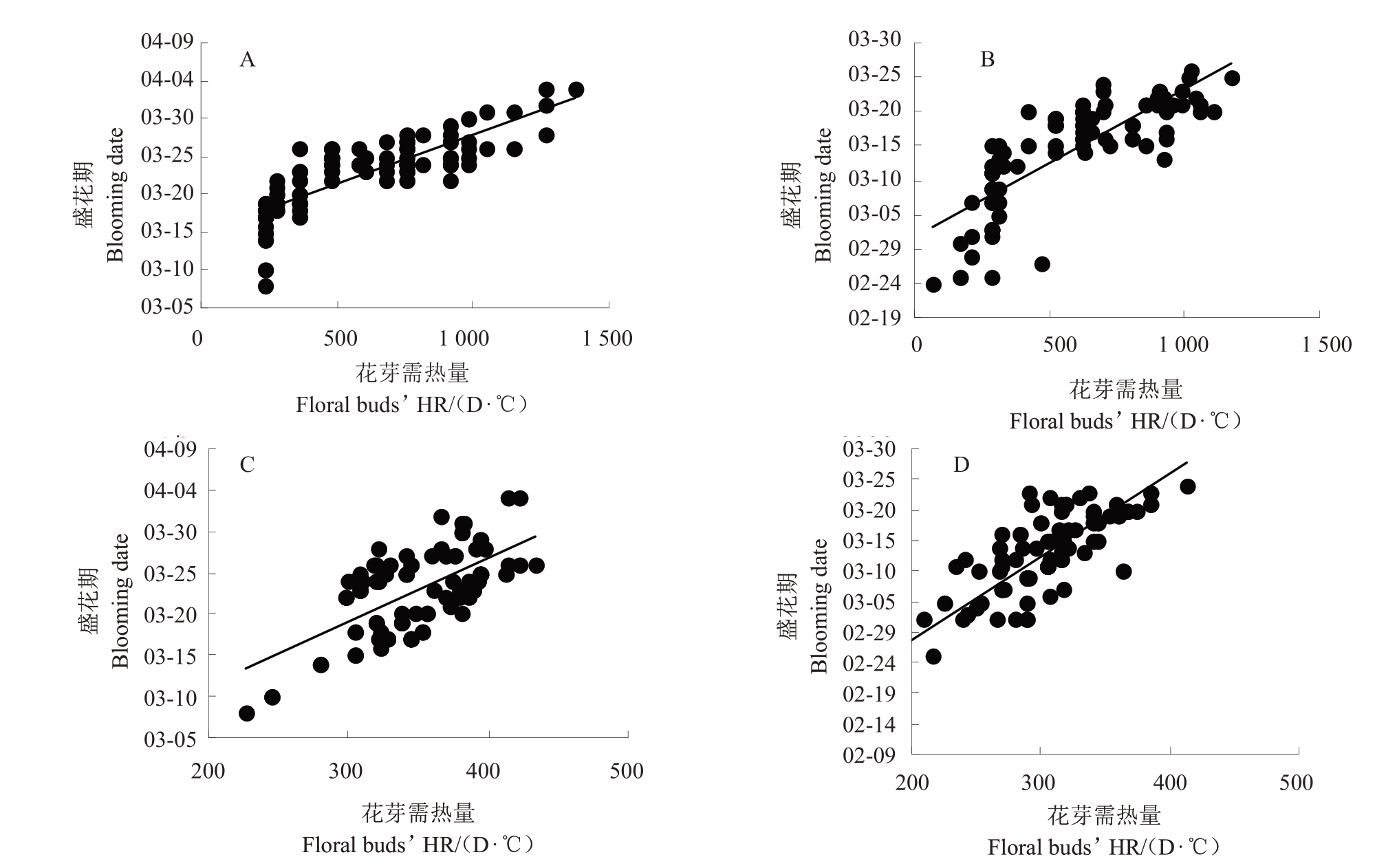
图6 花芽需冷量和需热量与盛花期的关系
Fig.6 Correlation of chilling and heat requirements in floral buds with blooming date
A,B. 0~7.2 ℃模型估算的花芽需冷量与盛花期关系(2018—2019;2019—2020);C,D. 有效积温模型估算的花芽需热量与盛花期关系(2018—2019;2019—2020)。
A,B.Correlation of CR of floral buds with blooming date by 0-7.2 ℃model(2018-2019;2019-2020);C,D.Correlation of HR of floral buds with blooming date by effective temperature model(2018-2019;2019-2020).
103份桃种质的需冷量和需热量与展叶期的关系比较结果见图7。采用0~7.2 ℃需冷量估算模型,连续2 a需冷量与展叶期均有一定关系,即需冷量低的种质,展叶较早;需冷量高的种质,展叶较晚(图7-A~B);对有效积温模型估算的叶芽需热量而言,连续2 a需热量低、高与展叶早、晚有较明显的关系,即需热量低的种质,展叶较早;需热量高的种质,展叶较晚(图7-C~D)。
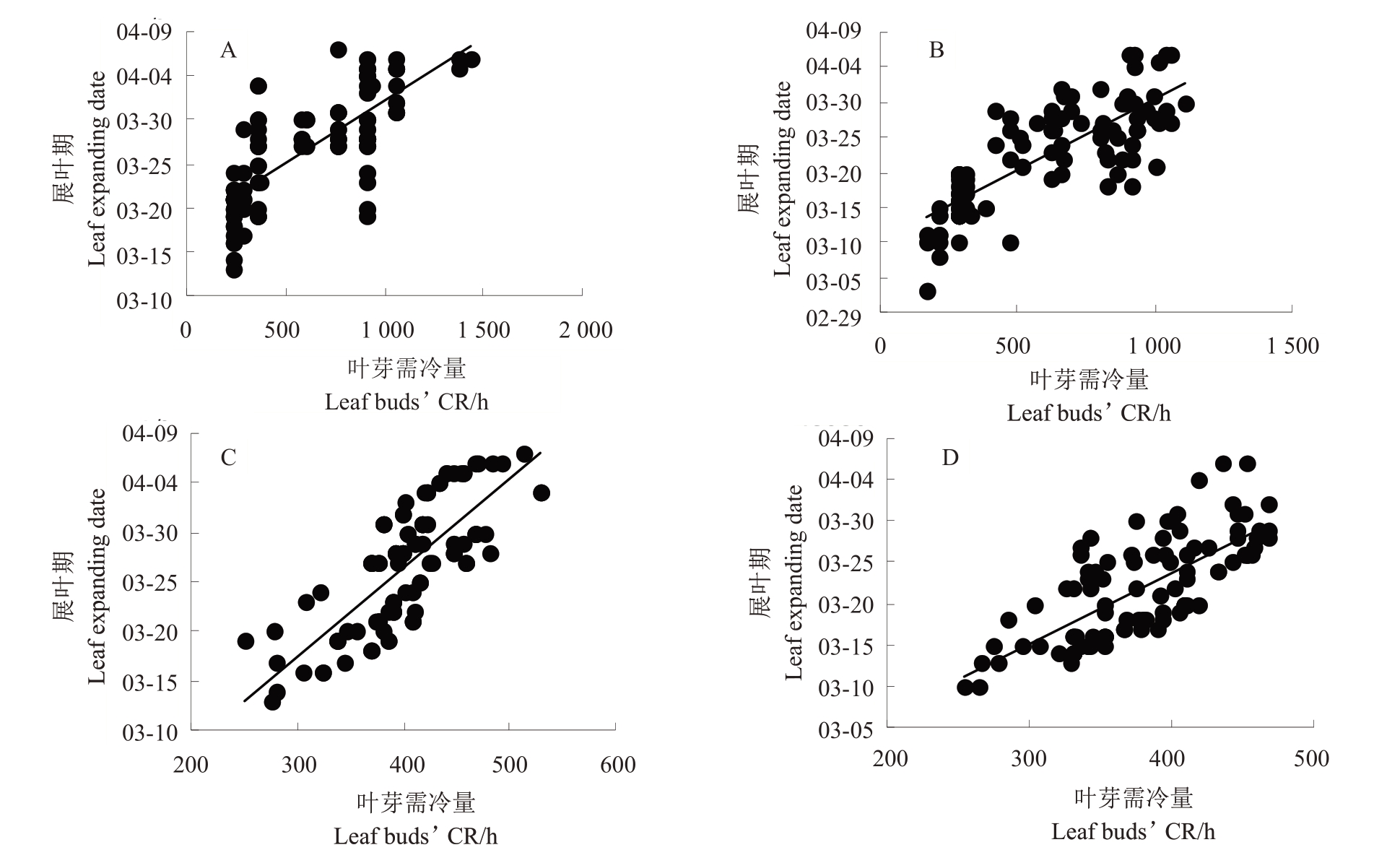
图7 叶芽需冷量和需热量与展叶期的关系
Fig.7 Correlation of chilling and heat requirements of leaf buds with blooming date
A,B. 0~7.2 ℃模型估算的叶芽需冷量与展叶期关系(2018—2019;2019—2020);C,D. 有效积温模型估算的叶芽需热量与展叶期关系(2018—2019;2019—2020)。
A,B.Correlation of CR in leaf buds with blooming date by 0-7.2 ℃model(2018—2019;2019—2020);C,D.Correlation of HR in leaf buds with blooming date byeffective temperature model(2018—2019;2019—2020).
3 讨 论
3.1 南京地区桃最佳需冷量和需热量模型
通过连续2 a的评估,初步得到0~7.2 ℃模型为该地区(南京)最佳需冷量估算模型。犹它模型应用表现很差,2018—2019年犹它模型对低需冷量种质无法评价,2019—2020 年冬季气温偏高,犹它模型完全不可用,这与前人报道[5,24]的犹它模型在低纬度地区寒冬季节只能有效预测高和中需冷量品种休眠的结束,不能有效预测低需冷量品种休眠的结束,在低纬度地区暖冬季节无法适用的结论一致。但是,该结果与姜卫兵等[1]的研究结果不同,其利用镇江南山农业科技示范园(与本试验地相距80 km)的桃材料试验,指出苏南地区落叶果树需冷量的评价建议采用犹它模型,可能是2018—2020 年气温(10.43 ℃,温度资料来自于国家果树种质南京桃资源圃气象站)较2001—2003年(8.83 ℃,温度资料来自于江苏省气象局)明显升高所导致。
在桃需热量的研究中,对评价模型优劣没有进行过明确的讨论比较。本文结果显示采用生长度时数模型测定的花芽和叶芽需热量年际间差异较大,可能是由于该模型的计算原理决定了计算结果极易受高温影响,温度越高,值会越大。因此,推论该模型在年际间气候差异较大、气温较高的情况下不适用。而采用有效积温模型测定的花芽和叶芽需热量时,年际间差异并不大,但是相较2018—2019 年,2019—2020年估算结果偏小,结合2019—2020年自然休眠结束期偏晚,同时开花和展叶提前1~2周,证实了前人研究结论,即过量低温可减少开花展叶所需的热量积累[25]。从年际间估算稳定性和简便快捷的角度考虑,有效积温模型更适合该气候区域桃品种资源需热量的估算。
由于目前需冷量和需热量的估算是基于物候学模型进行的,其结果较易受品种、地域、环境和气候条件等因素的影响,不同研究得到的结论会有一定的差异,未来研究应注重利用控制休眠的生物化学和生理机制信息进行方法创新,开发评价需冷量和需热量的生态生理学模型。
3.2 桃花芽、叶芽的需冷量和需热量的比较
国内外对桃花芽与叶芽的需冷量比较研究较多[12,19,21,26-27],评价的品种、样本量、地域和年度气候等因素差异都可能影响研究结果。沈元月等[12]和高志红等[19]分别对27份和11份桃进行研究发现,叶芽需冷量一般等于或高于花芽;而高东升等[26]和马融等[27]分别对18份和92份桃进行研究,结果表明花芽需冷量一般等于或高于叶芽。本文同时对103份种质的比较结果显示花芽和叶芽的需冷量基本一致,筛选到2份表现特异的种质,包括‘帚形山桃’和‘红花山桃’(叶芽需冷量约为花芽的5倍),导致该性状关系特异的机制还有待进一步研究。
对桃花芽与叶芽需热量的比较研究仅见张晓云等[10]的报道。笔者发现桃花芽需热量基本低于叶芽需热量,这与张晓云等[10]的研究结果(所试材料仅7份)相反,这可能与所试品种和样本量不同有关。
包括桃在内的很多植物均具有先花后叶的生长繁殖策略,以减少叶片覆盖,从而提高传粉效率[28]。花芽与叶芽冷、热需求量的差异具有重要的生物学意义,是桃先花后叶的影响因素之一。郭梁等[17]研究发现杏和山桃叶芽和花芽需冷量几乎相同,而叶芽需热量却是花芽的两倍之多,即叶芽需热量高于花芽是所试材料先花后叶的主要原因。本研究得到类似的结果,103份桃中有101份种质花芽和叶芽的需冷量基本一致,花芽需热量均较明显低于叶芽。同时,笔者还发现‘帚形山桃’和‘红花山桃’表现特异,该两份种质的叶芽需冷量约是花芽的5 倍(‘帚形山桃’叶芽和花芽需冷量分别为764 h 和151 h;‘红花山桃’叶芽和花芽需冷量分别为869 h和180 h),但需热量差异并不明显(‘帚形山桃’叶芽和花芽需热量分别为315 D·℃和295 D·℃;‘红花山桃’叶芽和花芽需热量分别为267 D·℃和262 D·℃),表明该两份山桃种质先花后叶主要是花芽需冷量明显低于叶芽所决定的,这与郭梁等[17]所试山桃的结果有异。山桃类型种质间表现出的差异,其机制还有待进一步研究。
3.3 桃芽冷、热需求量之间及与开花展叶的关系
针对桃芽冷热需求量之间的关系,研究结果有异。沈元月等[12]研究发现27 份桃花芽需冷量与需热量之间无内在的直接关系;胡瑞兰等[13]研究结果表明16 份桃花芽需冷量和需热量之间呈极显著正相关,张晓云等[10]也发现(所试材料仅7 份)花芽需冷量与需热量之间均呈显著正相关,另外该研究还发现叶芽需冷量与需热量之间也呈显著正相关。陈茂铨等[8]研究结果正好相反,发现12 份桃花芽需冷量和需热量之间呈显著负相关。本文研究结果与沈元月等[12]的结果一致,桃芽需冷量与需热量之间无显著相关关系。在上述研究人员的研究中,所试样本量偏少,结论代表性不强。本文采用103 份种质对桃芽冷热需求量之间的关系进行研究,结果相对而言更为准确,但是今后仍需增加样本量进行佐证。
大多数研究结果都认为,需冷量与开花时期呈正相关,需冷量越低,开花越早,需冷量越高,开花越晚,需热量则对开花没有明显的影响[29-30]。但是近年的研究发现需热量对开花的影响也不容忽视,如Alonso等[31]认为杏品种的需热量比需冷量对开花期的调控更为重要。Razavi 等[7]在桃上得出类似结论,并提出对于需热量的准确评价,有利于筛选出晚开花的品种。笔者研究发现,连续2 a花芽需冷量和需热量与开花早晚、叶芽需冷量和需热量与展叶早晚,均或强或弱地呈现出一定的正相关,即需冷量和需热量低的种质,开花展叶早,需冷量和需热量高的种质,开花展叶晚。
4 结 论
适宜南京气候区域桃需冷量和需热量估算的模型分别是0~7.2 ℃模型和有效积温模型;103份桃种质花芽和叶芽的需冷量和需热量值范围广,分别为151~1 264 h 和187~1 108 h,256~391 D·℃和267~498 D·℃;花芽需冷量与叶芽基本一致,需热量则基本低于叶芽;需冷量与需热量无相关关系,二者对开花展叶均起重要作用。
[1] 姜卫兵,韩浩章,戴美松,汪良驹,马凯.苏南地区主要落叶果树的需冷量[J].果树学报,2005,22(1):75-77.JIANG Weibing,HAN Haozhang,DAI Meisong,WANG Liangju,MA Kai. Study on the chilling requirement of leading deciduous fruit cultivars in southern part of Jiangsu province[J].Journal of Fruit Science,2005,22(1):75-77.
[2] EGGERT F P.A study of rest varieties of apple and in other fruit species grown in New York State[J]. Proceeding Journal of the American Society for Horticultural Science,1951,51:169-178.
[3] WEIBERGER J H. Chilling requirements of peach varieties[J].Proceedings of the American Society for Horticultural Science,1950,56:122-128.
[4] RICHARDSON E A,SEELEY S D,WALKER D R. A model for estimating the completion of rest for‘Redhaven’and‘Elberta’peach trees[J].Horticultural Science,1974,9(4):331-332.
[5] 王力荣,朱更瑞,方伟超,左覃元.桃品种需冷量评价模式的探讨[J].园艺学报,2003,30(4):379-383.WANG Lirong,ZHU Gengrui,FANG Weichao,ZUO Qingyuan.Estimating models of the chilling requirement for peach[J].Acta Horticulturae Sinica,2003,30(4):379-383.
[6] PAWASUT A,FUJISHIGE N,YAMANE K,YAMAKI Y,HONJO H. Relationships between chilling and heat requirement for flowering in ornamental peaches[J]. Journal of the Japanese Society for Horticultural Science,2004,73(6):519-523.
[7] RAZAVI F,HAJILOU J,TABATABAEI S J,DADPOUR M R.Comparison of chilling and heat requirement in some peach and apricot cultivars[J].Research in Plant Biology,2011,1(2):40-47.
[8] 陈茂铨,叶伟其,刘卓香,钟汉春,柳旭波,潘芝梅.12 个桃品种的花芽休眠需冷量和开花需热量[J]. 林业科学,2012,48(1):6-90.CHEN Maoquan,YE Weiqi,LIU Zhuoxiang,ZHONG Hanchun,LIU Xubo,PAN Zhimei. The requirements of chilling for bud dormancy and caloric for blooming for 12 peach varieties[J].Scientia Silvae Sinicae,2012,48(1):86-90.
[9] LEIDA C,JOSE F,ROMEU,JESUS G B,RIOS G,BADENES M L.Gene expression analysis of chilling requirements for flower bud break in peach[J].Plant Breeding,2012,131(2):329-334.
[10] 张晓云,杨伟伟,费青青,王生海,容新民.北疆地区设施主栽桃品种需冷量和需热量研究[J].黑龙江农业科学,2019(7):24-29.ZHANG Xiaoyun,YANG Weiwei,FEI Qingqing,WANG Shenghai,RONG Xinmin.Study on the chilling and heat requirment for peach cultivars used in protected facility in Northern Xinjing Area[J]. Heilongjiang Agricultural Sciences,2019(7):24-29.
[11] KWON J H ,NAM E Y,YUN S K ,KIM S J,SONG S Y,LEE J H,HWANG K D.Chilling and heat requirement of peach cultivars and changes in chilling accumulation spectrums based on 100-year records in Republic of Korea[J].Agricultural and Forest Meteorology,2020,108(9):288-289.
[12] 沈元月,郭家选,祝军,贾克功.早熟桃品种需冷量和需热量的研究初报[J].中国果树,1999(2):21-22.SHEN Yuanyue,GUO Jiaxuan,ZHU Jun,JIA Kegong. Preliminary report on chilling and heat requirements of early peach varieties[J].China Fruits,1999(2):21-22.
[13] 胡瑞兰,贾永祥. 影响温室桃成熟期的因子研究[J]. 山西果树,2002(3):4-5.HU Ruilan,JIA Yongxiang. Study on the causes of ripening stage of peach in shadow and temperature[J]. Shanxi Fruits,2002(3):4-5.
[14] MAULION E,VALENTINI G H,KOVALEVSKI L,PRUNELLO M,MONTI L L,DAORDEN M E,CERVIGNI G D L.Comparison of methods for estimation of chilling and heat requirements of nectarine and peach genotypes for flowering[J]. Scientia Horticulturae,2014,177(2):112-117.
[15] SPARKS D. Chilling and heating model for pecan bud break[J].Journal of the American Society for Horticultural Science,1993,118(1):29-35.
[16] ANDERSON J L,RICHARDSON E A,KESNER.Validation of chill unit and flower bud phenology models for "Montmorency"sour cherry[J].Agricultural Horticulturae,1986,184(7):71-78.
[17] 郭梁,LUEDELING E,戴君虎,许建初.叶芽花芽需热量差异导致植物先花后叶[J]. 植物分类与资源学报,2014,36(2):245-253.GUO Liang,LUEDELING E,DAI Junhu,XU Jianchu. Differences in heat requirement of flower and leaf buds make hysteranthous trees bloom before leaf unfolding[J]. Plant Diversity and Resources,2014,36(2):245-253.
[18] 王力荣,朱更瑞,左覃元.中国桃品种需冷量的研究[J].园艺学报,1997,24(2):194-196.WANG Lirong,ZHU Gengrui,ZUO Qingyuan. Studies on the chilling requirement of peach varieties[J].Acta Horticulturae Sinica,1997,24(2):194-196.
[19] 高志红,张君毅,乔玉山,常有宏,蔺经,章镇.桃和李品种需冷量研究[J].中国果树,2004(3):20-23.GAO Zhihong,ZHANG Junyi,QIAO Yushan,CHANG Youhong,LIN Jing,ZHANG Zhen. Study on the chilling requirement of peach and plum varieties[J].China Fruits,2004(3):20-23.
[20] 朱更瑞,方伟超,王力荣.观赏桃品种需冷量的研究[J].植物遗传资源学报,2004,,5(2):176-178.ZHU Gengrui,FANG Weichao,WANG Lirong.Chilling requirement of oranamental peach[J].Journal of Plant Genetic Resources,2004,5(2):176-178.
[21] CITADIN I,RASEIRA M C B,HERTER F G,SILVA J B. Heat requirement for blooming and leafing in peach[J]. Hortscience,2001,36(2):305-307.
[22] 王力荣,朱更瑞.桃种质资源描述规范和数据标准[M].北京:中国农业出版社,2005.WANG Lirong,ZHU Gengrui. Description specification and data standard of peach germplasm resources[M]. Beijing: China Agriculture Press,2005.
[23] DAVIDSON A,SILVA D D,DEJONG T M.The phyllochron of well-watered and water deficit mature peach trees varies with shoot type and vigour[J].Annals of Botany Plants,2017,9(5):1-9.
[24] ALLAN P. Measuring winter chilling in areas with mild winters[J].Deciduous Fruit Grower,1999,49(10):1-10.
[25] OKIE W R,BLACKBURN B. Increasing chilling reduces heat requirement for floral bud break in peach[J]. American Society for Horticultural Science,2011,46(2):245-252.
[26] 高东升,束怀瑞,李宪利.几种适宜设施栽培果树需冷量的研究[J].园艺学报,2001,28(4):283-289.GAO Dongsheng,SHU Huairui,LI Xianli.A study on bud chilling requirements of fruit trees in greenhouse[J]. Acta Horticulturae Sinica,2001,28(4):283-289.
[27] 马融,李道高.川南地区引种桃品种的需冷量研究[J].中国农学通报,2005,21(10):248-250.MA Rong,LI Daogao.A study on chilling requirement of peach varieties in South of Sichuan Basin[J].Chinese Agricultural Science Bulletin,2005,21(10):248-250.
[28] DAFNI A,NOY M C I. Lifecycle variation in geophytes[J].Annals of the Missouri Botanical Garden,1981,68(4):652-660.
[29] JOSE E,ENCARNACION O,PEDRO M G. Chilling and heat requirements of almond cultivars for flowering[J]. Environmental and Experimental Botany,2003,50(1):79-85.
[30] RUIZ D,JOSE A C,JOSE E. Chilling and heat requirements of apricot cultivars for flowering[J]. Environmental and Experimental Botany,2007,61(3):254-263.
[31] ALONSO J M,ANSON J M,ESPIAU M T. Determination of endo-dormancy break in almond flower buds by a correlation model using the average temperature of different day intervals and its application to the estimation of chill and heat requirements and blooming date[J]. Journal of the American Society for Horticultural Science,2005,130(3):308-318.